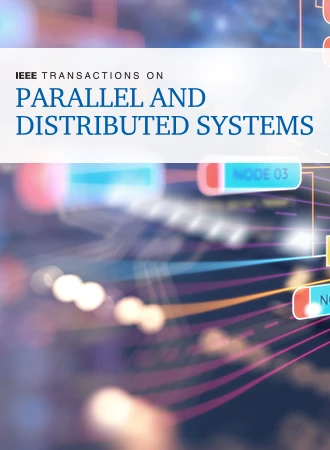Online Elastic Resource Provisioning With QoS Guarantee in Container-Based Cloud Computing
IF 5.6
2区 计算机科学
Q1 COMPUTER SCIENCE, THEORY & METHODS
IEEE Transactions on Parallel and Distributed Systems
Pub Date : 2024-12-24
DOI:10.1109/TPDS.2024.3522085
引用次数: 0
Abstract
In cloud data centers, the exponential growth of data places increasing demands on computing, storage, and network resources, especially in multi-tenant environments. While this growth is crucial for ensuring Quality of Service (QoS), it also introduces challenges such as fluctuating resource requirements and static container configurations, which can lead to resource underutilization and high energy consumption. This article addresses online resource provisioning and efficient scheduling for multi-tenant environments, aiming to minimize energy consumption while balancing elasticity and QoS requirements. To address this, we propose a novel optimization framework that reformulates the resource provisioning problem into a more manageable form. By reducing the original multi-constraint optimization to a container placement problem, we apply the interior-point barrier method to simplify the optimization, integrating constraints directly into the objective function for efficient computation. We also introduce elasticity as a key parameter to balance energy consumption with autonomous resource scaling, ensuring that resource consolidation does not compromise system flexibility. The proposed Energy-Efficient and Elastic Resource Provisioning (EEP) framework comprises three main modules: a distributed resource management module that employs vertical partitioning and dynamic leader election for adaptive resource allocation; a prediction module using基于容器的云计算中QoS保障的在线弹性资源发放
在云数据中心中,数据的指数级增长对计算、存储和网络资源的需求越来越高,特别是在多租户环境中。虽然这种增长对于确保服务质量(QoS)至关重要,但它也带来了诸如波动的资源需求和静态容器配置等挑战,这些挑战可能导致资源利用不足和高能耗。本文讨论了多租户环境的在线资源供应和高效调度,旨在最大限度地减少能源消耗,同时平衡弹性和QoS需求。为了解决这个问题,我们提出了一个新的优化框架,将资源供应问题重新表述为更易于管理的形式。通过将原来的多约束优化简化为一个集装箱布局问题,采用内点障碍法将优化简化,将约束直接集成到目标函数中,提高了计算效率。我们还引入弹性作为平衡能源消耗与自主资源扩展的关键参数,确保资源整合不会损害系统灵活性。提出的节能弹性资源配置框架包括三个主要模块:分布式资源管理模块,采用垂直分区和动态领导者选举进行自适应资源分配;预测模块采用$\omega$步预测法对资源需求进行准确预测;弹性调度模块,可根据租户扩展需求动态调整,优化资源分配,最大限度地降低能耗。在不同云场景中进行的大量实验表明,与已建立的基线相比,EEP框架显著提高了能源效率和资源利用率,支持可持续的云管理实践。
本文章由计算机程序翻译,如有差异,请以英文原文为准。
求助全文
约1分钟内获得全文
求助全文
来源期刊

IEEE Transactions on Parallel and Distributed Systems
工程技术-工程:电子与电气
CiteScore
11.00
自引率
9.40%
发文量
281
审稿时长
5.6 months
期刊介绍:
IEEE Transactions on Parallel and Distributed Systems (TPDS) is published monthly. It publishes a range of papers, comments on previously published papers, and survey articles that deal with the parallel and distributed systems research areas of current importance to our readers. Particular areas of interest include, but are not limited to:
a) Parallel and distributed algorithms, focusing on topics such as: models of computation; numerical, combinatorial, and data-intensive parallel algorithms, scalability of algorithms and data structures for parallel and distributed systems, communication and synchronization protocols, network algorithms, scheduling, and load balancing.
b) Applications of parallel and distributed computing, including computational and data-enabled science and engineering, big data applications, parallel crowd sourcing, large-scale social network analysis, management of big data, cloud and grid computing, scientific and biomedical applications, mobile computing, and cyber-physical systems.
c) Parallel and distributed architectures, including architectures for instruction-level and thread-level parallelism; design, analysis, implementation, fault resilience and performance measurements of multiple-processor systems; multicore processors, heterogeneous many-core systems; petascale and exascale systems designs; novel big data architectures; special purpose architectures, including graphics processors, signal processors, network processors, media accelerators, and other special purpose processors and accelerators; impact of technology on architecture; network and interconnect architectures; parallel I/O and storage systems; architecture of the memory hierarchy; power-efficient and green computing architectures; dependable architectures; and performance modeling and evaluation.
d) Parallel and distributed software, including parallel and multicore programming languages and compilers, runtime systems, operating systems, Internet computing and web services, resource management including green computing, middleware for grids, clouds, and data centers, libraries, performance modeling and evaluation, parallel programming paradigms, and programming environments and tools.
 求助内容:
求助内容: 应助结果提醒方式:
应助结果提醒方式:


